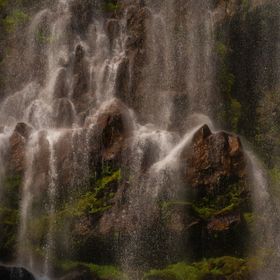

lanceo
Follow
Water droplets drape over rock formations at the edge of Spray Falls on the northern face of Mt Rainier.
Water droplets drape over rock formations at the edge of Spray Falls on the northern face of Mt Rainier.
Read less
Read less
Views
132
Likes
Awards
Action Award
Zenith Award
Curator's Selection
Top Shot Award 22
Spring 21 Award
Legendary Award
Elite
Top Ranks
Categories
Same photographer See allBehind The Lens
Discover more photos See all
Behind The Lens
Location
Spray Falls, Mt. Rainier, WashingtonTime
The 354 foot Spray Falls is located on the north-west edge of Mt Rainier accessible during the longer days of Summer and Fall. Full light conditions this time of year, start in the early afternoon with the shadows forming a few hours later when the as the sun moves west behind the ridge; when I shot this part of the series.Lighting
Spray Falls flows down a convex basaltic cliff face over 400 feet above where this shot was taken. The shape of the rock spreads the water out creating a succession of mini falls like shown, so late afternoon light create ideal conditions to capture the action as I have.Equipment
I used my Sony A7R III with both a f/2.8 24-70mm and a 70-300mm variable aperture. Although I use the 24-70mm for a vast majority of my field work, especially responsive in variable light conditions of forests, where I do most of my work, being born far sighted, I love the "live" light of the 70-300mm for work like this. For me, the way it brings out contrast, volume and color nuances provides depth cues that leads to some truly exciting renderings I do not see otherwise. For this shot in particular, I was shooting with the 70-300 at f/5 which allowed me to move out of the mist of the waterfall while gathering minute detail and contrast. The gyroscopic stabilization of the A7R III means I rarely if ever, have to use a tripod. Really, ever.Inspiration
Although I have been doing fine art landscape and travel photography most of my life, it wasn't till I survived a pretty tough bout with Cancer that I re-discovered my love of photography. Early in that period of re-discovery, I became fascinated with the myriad ways water in all its forms, plays a role in shaping the Pacific Northwest and was struck by the potential to explore water as its own subject. Not as a subject subordinate to human concerns about its qualities and uses, but as the primary subject front and center. To that end, the "Water Portraits" series was born, which this work builds upon. Slowing the water, shooting across the area of its movement and providing an intimate portrait of its action upon the it's own subject, the basaltic rock, all work toward the larger goals of the series.Editing
A designer by trade, I utilize Photoshop for basic RAW processing, then utilize the free version of NIK to make color, contrast and structural enhancements. I generally take a series of shots for every shot I take in the field, so I rarely crop.In my camera bag
I work with Canon, Sony and a number of VR Cameras, primarily Insta360. For this shoot, I was working with my Sony kit. As far as equipment, the vast majority of what I have the field is safety related as I work from 0-13,000 feet in some pretty remote and treacherous areas. Although I have a "standard" set of lenses for each setup, I typically use the Sony A7R III, my 24-70mm and 70-300mm and a smaller 5K VR Camera. Of course, extra batteries and SD Cards in Pelican cases, but otherwise, its safety gear. So, in Washington anyways, safety gear is good shoes, a hat, bear spray, water, first aid kit, maps with backstops, knife, flashlight, backup batteries, survival gear and last but not least, an InReach Explorer+ emergency beacon with medical bivouac insurance.Feedback
I feel like a lot of what is talked about in the photography community is about the technical, about the gear, about the logistics, about locations, about other people's expectations for you as a storyteller. Since you invited me, I'd like to share a few thoughts about what I have found that may be useful as far as essential subjects and the need for inspiration. Of all the natural subjects, water is the most pervasive, abundant and versatile substance in the world in terms of mood, dynamic, variety and form. It creates mountains and lakes, and helps color the sky. It is vital to all living things, and, it can re-shape entire land and culture in a matter of seconds. It carries insights about its origin and hints at its intended course of action. To date, most people approaching "water" as a subject have focused on human concerns; aesthetics (ex:the meditative, seascapes or, its use to signify wealth in architecture etc.),or, its availability as a resource vital to survival. In a world where billions of pictures are taken every day, very little rises to the attention of the photographic community about water as a wholly contained subject unto itself. Although I think there is much to be learned by reading about, critiquing, copying and extrapolating on anothers' work that came before you, there are conceptual, aesthetic and physical limits for how far you can draw from those points in time. To that end, the first step in finding something new, is believing you can. In closing, having been part of a number of online photographic communities, ViewBug has been the best. Not so much about being seen, as having a place to BE. I am grateful and humbled for folks lifting my works up, taking their time, to see how I am spending mine. Keep sharing!










































